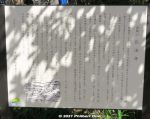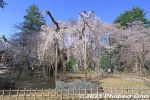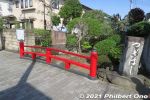Mamasan Guhoji Temple 真間山 弘法寺
|
|
|

Guhoji is a Nichiren Buddhist temple founded by Priest Gyoki in 737. It's on a small hill noted for cherry blossoms and autumn foliage.Priest Kobo Daishi (Kukai) later reconstructed and expanded the temple in 822. Tokugawa Ieyasu, before he became shogun, granted the temple ownership of its temple grounds in 1591. In 1695, Mito Komon named the temple's tea ceremony room "Henrantei" (遍覧亭). In 1888, the entire temple was destroyed by fire. The present structures were reconstructed in 1890.
|
|

"Mamasan" is the temple's mountain name. Not the same as a mama-san operating a Japanese bar. Photo shows Mama no Tsughihashi Bridge leading to the steps going up to Guhoji Temple on a wooded hill. 真間の継橋
|
|

Niomon Gate at the top of the steps, Guhoji's front gate. The two columns house a pair of Nio kings considered to be the protectors of the temple. 仁王門
|
|

After Niomon Gate, this is the first building you see, Soshido Hall dedicated to Nichiren, founder of the Nichiren Buddhist sect. Reconstructed in 2010 on the 700th anniversary of Nichiren's death. 祖師堂 There are other temple buildings spread out on the hill.
|
|

In spring, Guhoji's 400-year-old weeping cherry blossom tree is famous. 伏姫桜
|
|

The weeping cherry tree looks different from different angles.
|
|

Guhoji's 400-year-old weeping cherry blossom tree is named "Fushihime Sakura." 伏姫桜
|
|

In Ichikawa, Chiba, Guhoji's 400-year-old weeping cherry blossom tree is named "Fushihime Sakura." 伏姫桜
|
|

We can see that a few branches had been cut, which means the tree was larger.
|
|
|
|

Another weeping cherry tree next to Fushihime Sakura.
|
|
|
|
|
|

View of Ichikawa Station area from Guhoji. The two skyscrapers are The Towers East on the left and The Towers West on the right. The higher Towers West building has a lookout deck on the 45th floor.
|
|

Niomon Gate rear view as you exit.
|
|

Going down the steps from Guhoji Temple. In the distance, The Towers West skyscraper is visible. The road ahead goes all the way to JR Ichikawa Station.
|
|

View from The Towers West lookout deck on the 45th floor. The patch of green is the hill where Guhoji is located.
|
|

"Temple" marks the location of Guhoji Temple on the wooded hill.
|
|

Mama no Tsughihashi Bridge near the steps going up to Guhoji Temple. The bridge is mentioned in some poems in the Man'yoshu. 真間の継橋
|
|

About Mama no Tsughihashi Bridge. 真間の継橋
|
|

Near Guhoji is Tekona Reijindo, another temple. We didn't go to see this temple though. (Too tired walking.) Tekona Reijindo is dedicated to a local girl named Tekona who lived 2,000 years ago. 手児奈霊神堂Her job was to fetch water from a well. She was such a beautiful girl that every man who saw her fell in love with her and wanted to marry her. They even fought over her. Even the moon fell in love with her. She got so distraught by all the attention and fighting that she drowned herself in the well. Poor girl, she was loved to death.
|
|

In 1501, Tekona's spirit told a priest to build a grave for her. This evolved into this temple where women pray for maternal happiness including safe childbirth and child rearing. 手児奈霊神堂
|
|

Poem about Tekona.
|
|

After Guhoji Temple, we walked back to Edogawa River along Mama River which had a few cherry blossoms.
|
|

Mama River cherry blossoms in Ichikawa, Chiba.
|
|

Western-style buildings along Mama River. The Christian church on the right is the Japan Evangelical Lutheran Church in Ichikawa and a National Tangible Cultural Property. 日本福音ルーテル市川教会【国登録有形文化財】
|
|

Mama River empties into Edogawa River. We later walked along Edogawa River toward Konodai Station on the Keisei Line.
|
|
|
|
|
|
|